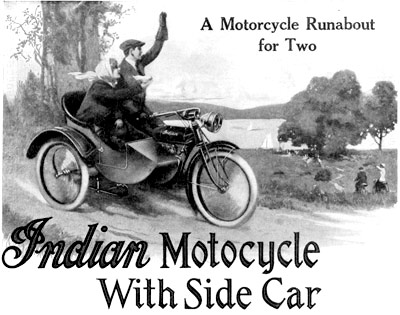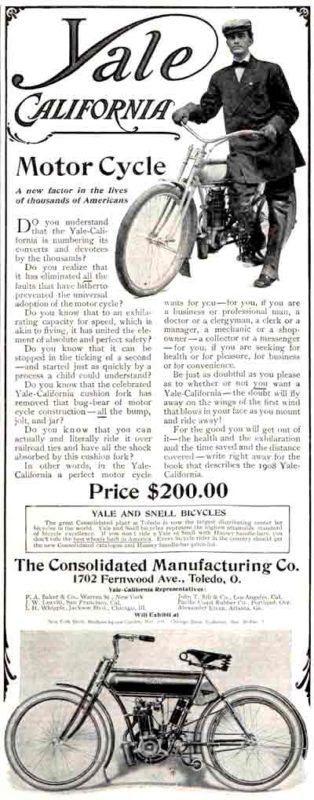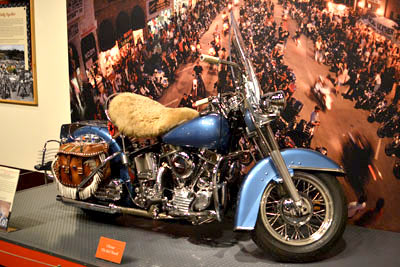Classic Art: Motorcycle Madness
“Soldier on Motorbike” by Lawrence Toney

“Soldier on Motorbike”
by Lawrence Toney
from October 20, 1917
Yes, motorcycles were used in World War I, as this 1917 Post cover indicates. The U.S. military used mainly Harley-Davidson or Indian bikes, and not surprisingly, the British used Triumph, while Germany used BMW motorbikes.
“The Army used an estimated 20,000 motorcycles during the war,” wrote Lisa Gregory in a 2003 issue of Soldiers Magazine. “In fact, the first American to enter Germany after the ceasefire was reported to be motorcycle dispatch rider Cpl. Roy Holz.”
In the first world war era you’d see motorcycles, cars, trucks, and airplanes juxtaposed with cavalry!
“Indian Bike Ad” – September 7, 1918

“Indian Bike Ad”
from September 7, 1918
This 1918 Indian ad confirms that thousands of bikes were placed in the service of the Allied armies.
Indian states: “our factories are working night and day to supply the needs of Uncle Sam. … We feel sure that our civilian customers who have suffered delay by this condition will be patient until such time as we can resume our regular deliveries.”
“Indian Police Motorcycles” – February 15, 1913

“Indian Police Motorcycles”
from February 15, 1913
Very early in motorbike history, police departments learned the advantage of their maneuverability and convenience. And supplying police and military became a competitive business early in the 20th century.
Although Harley-Davidson delivered a bike to the Detroit Police Department in 1908, this ad from a February 1913 issue of the Post shows the Detroit police with squad of Indian bikes.
Click here for a virtual museum on the history of motor law enforcement.
“Indian Motorcycle With Side Car” – May 9, 1914

“Indian Motorcycle With Side Car Ad”
from May 9, 1914
This 1914 ad shows that bikes were not just for work. The ad says this motorcycle with sidecar has all the touring comfort and efficiency of an automobile at the cost of trolley fares.
“A spin on a summer’s evening. A weekend trip. A coast-to-coast tour,” the ad rhapsodizes. Well, I don’t see that last one happening on 1914 roads, but we get the idea.
“Yale Bike Ad” – November 2, 1907

“Yale Bike Ad”
from November 2, 1907
The first motorcycle ads in the Post appeared in 1907—105 years ago! This ad appeared in November of that year for a 1908 Yale California advertised for $200. It is difficult to imagine how many folks could afford that kind of outlay, which would be around $5,000 in today’s dollars.
“Tex’s Motorcycle” by Stevan Dohanos

“Tex’s Motorcycle”
by Stevan Dohanos
from April 7, 1951
We showed this cover last year in a piece about illustrator Stevan Dohanos. See more of his work in The Great Covers of Stevan Dohanos.
Mil Blair, an expert at bike building, restored the Harley-Davidson. Blair saw the bike on the Post cover when he was 11 years old and fell in love with it, undoubtedly like every other boy who saw that issue. But wait until you see it today!
“Tex’s Motorcycle”

Photo by Dwight Lamb of The Saturday Evening Post
What are the chances of a long-time staffer for The Saturday Evening Post running across a motorcycle made famous by that 1951 Post cover…literally right down the street? The Post’s Dwight Lamb is a frequent visitor to the beautiful Eiteljorg Museum in Indianapolis. Although the Eiteljorg is known for a superb collection of Indian and Western art, the museum was having a display of classic, outlandish or otherwise unique motorcycles. Lamb was stunned when he turned a corner and saw this big, blue…and oddly familiar bike. And yes, motorcycle buffs, Mil Blair, who restored this beauty, rode this classic to the annual Sturgis Motorcycle Rally.
Acknowledgements:
- The history of motorcycle companies like Harley-Davidson are available online and are interesting even if you’re not a motorcycle buff! Click here for the history of the Indian Motorcycle.
- A special thank you to Dwight Lamb, who rediscovered and photographed our big, beautiful Harley.